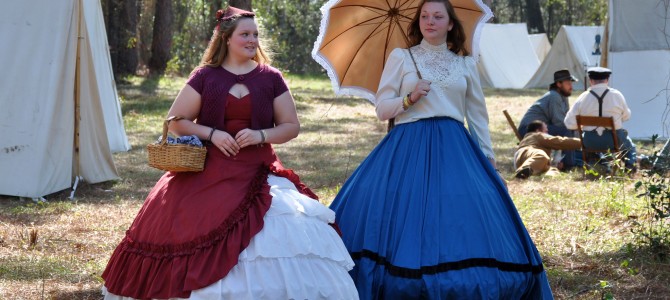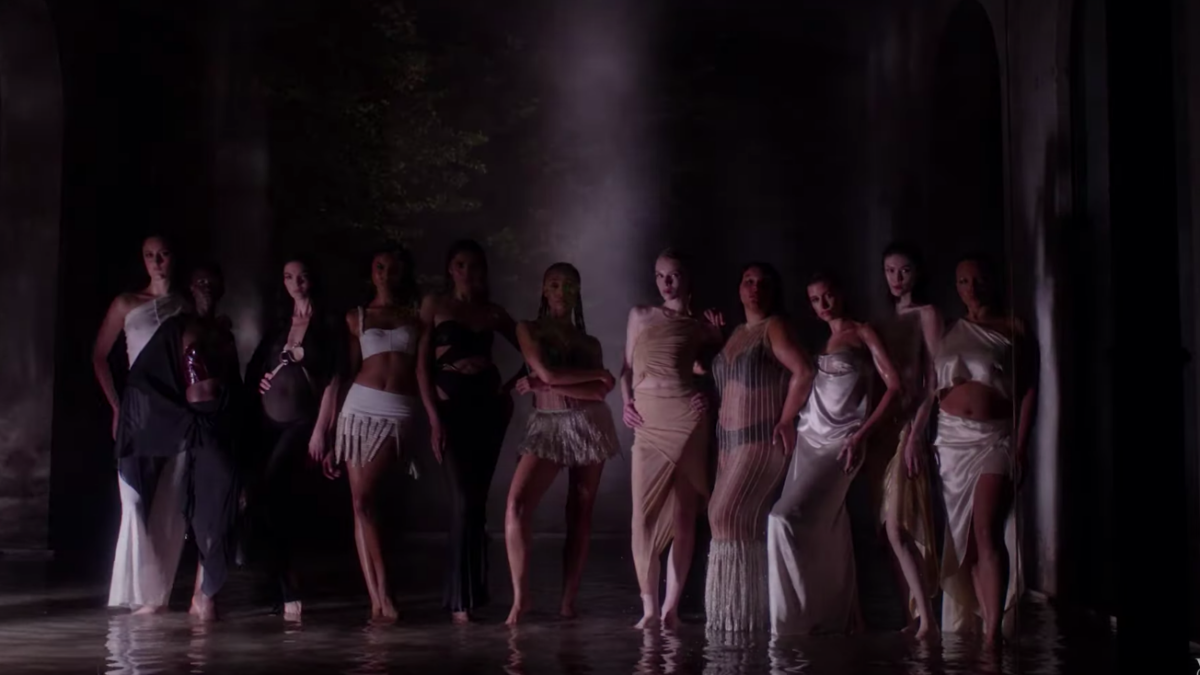
In a scrapbook in my parents’ home is an old, faded picture of my mother wearing an elegant yellow dress with a wide hoop skirt. Her long, dark hair falls in waves down her back, and her blue eyes sparkle beneath a yellow hat as she smiles for the camera.
The picture was taken decades ago, during an event at her all-girls college in a small Georgia town. I always loved that photograph. My mother reminded me of Scarlett in “Gone With the Wind,” only more beautiful—seriously.
Little did I know that my lovely mother, one of the kindest, most gracious people I’ve ever known, is a racist. Or, as Elizabeth Boyd of the Washington Post would say, maybe not quite a racist, but exclusionary nonetheless—and long overdue for being knocked from her “inglorious perch” in American culture.
Who Knows What Hoop Skirts Will Lead To
Boyd’s scathing critique of Southern belles came in response to the University of Georgia’s ban of the hoop skirt from all school events. The ban happened in March, a week after the University of Oklahoma expelled two fraternity members and shut down their chapter because of a racist video members made.
Worried that they might be seen as racist, too, administrators, faculty, and Greek organizations at UGA scurried together to do something about those hateful hoop skirts. They’d already banned Confederate uniforms, but that wasn’t enough. Hoop skirts, like the dreaded Confederate flag, might induce someone to commit a hateful crime. It had to be stopped. So they banned them faster than you can say “Huckleberry Finn.”
Boyd says it’s not enough (is it ever with these people?). She doesn’t just want the hoop skirt gone, she wants the Southern belle persona gone as well, and anything associated with her. Whether it’s sorority rush where family ties are such a big deal, beauty pageants, or sporting traditions (I can only assume she’s talking about NASCAR—yeah, try banning that), all of it must go because it reeks of white Southerners living in the past, celebrating “nostalgia for a bygone, segregated South and all its attendant privileges.”
In highly stylized renditions of femininity (which differ markedly from their day-to-day routines and visage), otherwise thoroughly contemporary collegians demonstrate their ability to “do” white Southern womanhood: the attire, the manners, the demeanor, the shared references and, above all, the lineage. Such performances stun with their continued ability to consolidate privilege and fly under the representational radar where masculine symbols have all but vanished. Discounted but powerful, these belle performances may not stem from conscious ill intent, but they are surely racial symbols as much as any noose or flag.
What’s so funny is that the hoop skirt has nothing to do with racism or exclusion. Quite the contrary. The hoop skirt wasn’t an invention of the antebellum South where rich white women floated around the plantation under a parasol as they looked down their noses at the slaves working in the scorching sun. The fact is, the hoop skirt had been around since the 1700s (and even long before that, depending on how you define a hoop skirt). It was a European fashion, straight from the Parisian courts.
Hoop Skirts: The Egalitarian Option
But hoop skirts weren’t just for the wealthy. While they certainly started out as high fashion, setting royalty apart from commoners, they quickly morphed into a populist form of dress in the nineteenth century. The hoop skirt was worn by all social classes and all racial groups. That’s right. Contrary to Boyd’s claim and the ignorance of the folks at UGA who banned it, the hoop skirt is a symbol of inclusion, not exclusion!
This fact stoked the ire of Queen Victoria, who complained during a visit to Paris that Western fashion such as the crinoline “diluted national dress to such an extent that everyone, whether Turkish, Scottish, Spanish or Tyrolean, dressed alike.” Not only were those pesky Turks wearing hoop skirts, maids were dressing like their mistresses, and, hold on—someone please alert the politically correct boobs at UGA—slaves and freed blacks in America were wearing them, too!
Even though many people associate the hoop skirt with Southern belles, just like in Europe, both white and black women wore crinoline, including Mary Todd Lincoln’s dressmaker, Elizabeth Keckley, who was a former slave. Keckley was an extraordinary woman who purchased her freedom and moved to Washington DC, where she would have better chances for work.
To support herself and her family, Keckley started her own dress-making business, creating stunning dresses with hoop skirts that she wore herself. She made dresses as a self-made businesswoman for the wives of both Jefferson Davis and Robert E. Lee, gaining success because of her keen business sense and talent. One could say that wearing a beautiful hoop skirt would be a celebration of seamstresses such as Keckley, a former slave who became an author and founder of the Contraband Relief Association.
Hoop Skirts Are an Emblem of Liberty
The fact that the hoop skirt was so common, however, was a source of disdain for the upper crust. George Routledge, who wrote etiquette manuals, published the following elitist diatribe in 1875:
After all that can be said there is no doubt that one of the objects of dress should be to enable people to do what they have to do in the best, the most convenient, and the most respectable manner. At all events it should not interfere with their occupation. Did our readers ever see a London housemaid cleaning the doorsteps of a London house? It is a most unedifying sight. As the poor girl kneels and stoops forward to whiten and clean the steps her crinoline goes up as her head goes down, and her person is exposed to the gaze of policemen and errand-boys, who are not slow to chaff her upon the size and shape of her legs. Can this be called dressing in good taste? Would it not be wiser to discard the crinoline altogether till the day’s work is done, and the servants make themselves tidy for their tea and their evening recreation. In some families this is insisted on. But, on the other hand, it is complained against as an infringement upon the liberty of the subject, which is an unreasonable complaint, as the subject may go elsewhere if she dislikes to have her liberty so interfered with.
Liberty. Servants considered the hoop skirt a symbol of liberty. For the first time, women of all walks of life were wearing the same style, even if it inconvenienced them in the practicalities of the day. Whether it was being worn by poor women outside of slab huts in Australia, maids in Paris, or slaves in America, the hoop skirt was not a symbol of exclusion or oppression. It was a symbol of freedom, crossing class barriers, and women being free to be women.
In their zeal to squash out the last vestiges of Southern culture, something Boyd finds so offensive that she wants to get rid of the very notion of a Southern lady, politically correct tyrants and their sycophants have made a stupid stumble with the hoop skirt. What they see as racist and exclusionary is the exact opposite. The hoop skirt is about liberty, equality, and inclusion. It should be celebrated, not banned.
The South Deserves Celebration
The same is true about so many aspects of Southern history and culture. It’s multifaceted and complex. Do we have a racist past? Yes, that’s part of it, but it’s not all of it. Most people don’t even realize that only a small fraction of the South even owned slaves, and of that fraction, a tiny number of people owned plantations. If you’re going to start setting fire to the South—banning our dress, our monuments, our culture—you’re going to destroy a proud and vibrant heritage that makes our nation richer.
The white Southern woman “with her attire, manners, and demeanor,” which Boyd hates so irrationally that it must be born of petty jealousy or just mere stupidity, has an identity that is beyond racism. It is an identity rooted in faith, family, individualism, quiet determination, social struggle, and freedom.
If Boyd or anyone can’t see beyond the red haze of their own prejudice, then they can just stay out of the South. We’re just fine down here the way we are, sipping our mint juleps, cooking up some tangy barbeque, praying with our kids before we tuck them in at night, and listening to Don Williams as the sun sets on our beautiful and cherished land.









